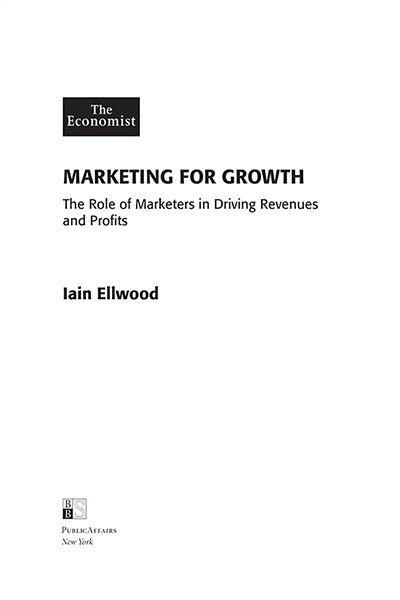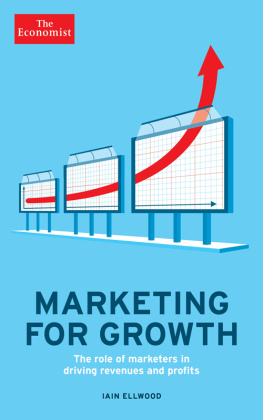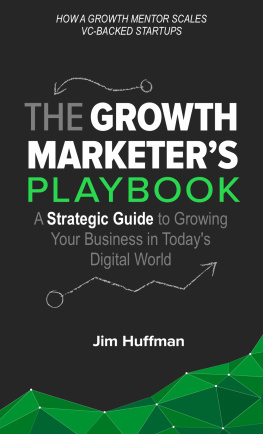MARKETING FOR GROWTH
OTHER ECONOMIST BOOKS
Guide to Analysing Companies
Guide to Business Modelling
Guide to Business Planning
Guide to Cash Management
Guide to Commodities
Guide to Decision Making
Guide to Economic Indicators
Guide to Emerging Markets
Guide to the European Union
Guide to Financial Management
Guide to Financial Markets
Guide to Hedge Funds
Guide to Investment Strategy
Guide to Management Ideas and Gurus
Guide to Managing Growth
Guide to Organisation Design
Guide to Project Management
Guide to Supply Chain Management
Numbers Guide
Style Guide
Book of Business Quotations
Book of Isms
Book of Obituaries
Brands and Branding
Business Consulting
Business Strategy
Buying Professional Services
Doing Business in China
Economics
Managing Talent
Managing Uncertainty
Marketing
Megachange the world in 2050
Modern Warfare, Intelligence and Deterrence
Organisation Culture
Successful Strategy Execution
The World of Business
Directors: an AZ Guide
Economics: an AZ Guide
Investment: an AZ Guide
Negotiation: an AZ Guide
Pocket World in Figures

THE ECONOMIST IN ASSOCIATION WITH
Public Affairs
Published by Profile Books Ltd
New York
The Economist in Association with Profile Books Ltd. and PublicAffairs
Copyright The Economist Newspaper Ltd, 2014
Text copyright Iain Ellwood, 2014
First published in 2014 by Profile Books Ltd. in Great Britain.
Published in 2014 in the United States by PublicAffairs, a Member of the Perseus Books Group
All rights reserved.
No part of this book may be reproduced, stored in or introduced into a retrieval system, or transmitted, in any form or by any means (electronic, mechanical, photocopying, recording or otherwise), without the prior written permission of both the copyright owner and the publisher of this book, except in the case of brief quotations embodied in critical articles and reviews. For information, address PublicAffairs, 250 West 57th Street, 15th Floor, New York, NY 10107.
The greatest care has been taken in compiling this book. However, no responsibility can be accepted by the publishers or compilers for the accuracy of the information presented.
Where opinion is expressed it is that of the author and does not necessarily coincide with the editorial views of The Economist Newspaper.
While every effort has been made to contact copyright-holders of material produced or cited in this book, in the case of those it has not been possible to contact successfully, the author and publishers will be glad to make amendments in further editions.PublicAffairs books are available at special discounts for bulk purchases in the U.S. by corporations, institutions, and other organizations. For more information, please contact the Special Markets Department at the Perseus Books Group, 2300 Chestnut Street, Suite 200, Philadelphia, PA 19103, call (800) 810-4145, ext. 5000, or e-mail special.markets@perseusbooks.com.
Library of Congress Control Number: 2013954402
ISBN 978-1-61039-397-3 (PB orig.)
ISBN 978-1-61039-398-0 (EB)
First Edition
10 9 8 7 6 5 4 3 2 1
To Hannah
Contents
Acknowledgements
MANY PEOPLE HAVE HELPED make this book possible.
First, I would like to thank those who have helped shape my thinking and been a source of much support and advice over the years: my parents, Jan and Robert Ellwood, my brothers, Andrew and Peter, Raymond Blanc, Simona Botti, Charlie Colquhoun, Paul Crisford, Simon Crisford, Morag Cuddeford-Jones, Jack Fraser, Adrian Furnham, Alastair Kingsland, David Martin, Noel Penrose, Evgeniya Petrova, Alistair Robinson, Kirsty Ross, Teresa Schrezenmaier and Grant Usmar.
I have worked with many business leaders to whom I am grateful for their expertise and experiences, including John Allert, Fred Brown, Rita Clifton, Isabelle M. Conner, Julian Dailly, Gabor Dani, Adi Godrej, Dominic Grounsell, Tiffany Hall, Chris Kersebergen, Larry Light, Andy Milligan, Geraldine OConnell, Clare Salmon, Simon Scoot, Simon Smith and David Still. I also owe a special debt to Frances Frei, UPS Foundation Professor of Service Management at Harvard Business School, whose teaching inspired me to champion brand marketing as a more effective way to generate profitable business growth.
On the publishing side, Stephen Brough and Penny Williams made all the difference with their clear and patient guidance. Thanks to them and everyone at Profile Books.
Most of all I would like to thank my wife, Hannah, to whom this book is dedicated, and without whose support and love I could not have written a word.
Iain Ellwood
November 2013
Introduction
MARKETING IS THE STRUCTURED PROCESS of targeting and engaging new and current customers in order to generate sales. Marketers, therefore, play a crucial role in generating revenue and they can play an equally important role in how revenues translate into profit. This is a guide to how marketers can improve their commercial focus and become more influential drivers of business growth. Businesses grow by becoming better at what they do, and by being smarter or more efficient, and this involves developing and improving products, processes, people and standards of service. Part of the marketing role is to pick up on changing customer needs and behaviour and the forces at play in markets and to do so ahead of the competition. If marketers do this well, they will increase their businesss prospects for growth, and their influence and impact within the business.
This book focuses on the role of marketers and the tools and methods available to them in identifying and achieving profitable growth. It puts marketing and marketers at the commercial heart of a business with responsibility for strengthening the links between a businesss operations and its customers. It examines each part of the growth life cycle, starting with the use of analytics to define the financial size of the prize and to measure the impact of marketing. It explains how to identify the more potentially rewarding customer targets, define more relevant and differentiated customer propositions, and make sure that employees deliver what is promised and that customers become greater advocates for the brand. It reinforces the need for marketing activities to be directly underpinned by strong commercial financial outcomes.
For marketers tired of being viewed by some as a cost, the challenge is to take more responsibility for the commercial results of the company. By becoming more financially fluent as well as more accountable and responsible for the commercial outcomes, they will gain greater authority and influence. This may require the development of new skills as well as an attitudinal shift, whereby they see themselves and behave as asset managers making investment and return decisions.
About this book
Each chapter is designed to stand on its own, and together the ten chapters are intended to form a convenient handbook of insights, methods, frameworks and tools for marketers to help them drive growth in their organisations. The chapters deal with the following:
1 Customer value management describes the importance of linking marketing activities with commercial outcomes and outlines the main ways that marketing can increase revenues and profits.
2 Return on investment: measurement and analytics defines the many different ways to statistically quantify the effectiveness of marketing activities and help predict future returns. The huge amount of customer data that is now available means marketers can make fact-based decisions about new business growth opportunities; prioritise which will deliver the best financial returns and decide how to best spend their marketing budgets.
Next page






